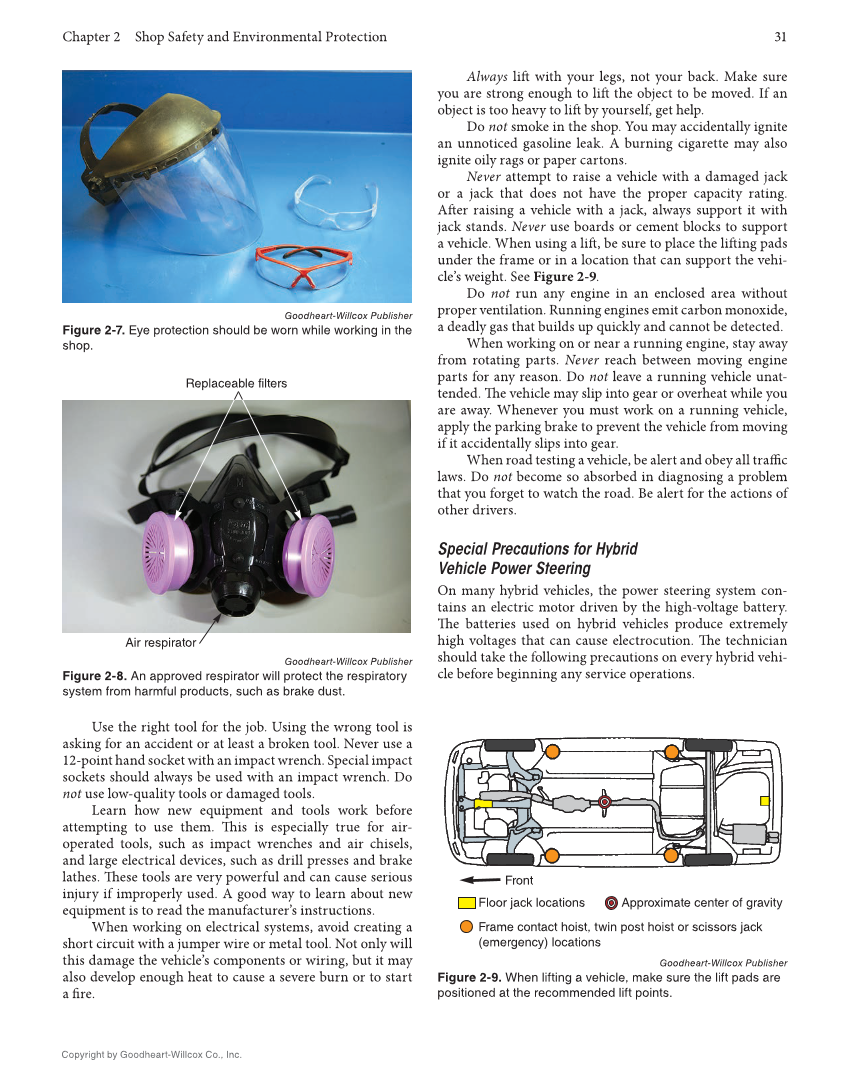Chapter 2 Shop Safety and Environmental Protection 31 Copyright by Goodheart-Willcox Co., Inc. Use the right tool for the job. Using the wrong tool is asking for an accident or at least a broken tool. Never use a 12-point hand socket with an impact wrench. Special impact sockets should always be used with an impact wrench. Do not use low-quality tools or damaged tools. Learn how new equipment and tools work before attempting to use them. Th is is especially true for air- operated tools, such as impact wrenches and air chisels, and large electrical devices, such as drill presses and brake lathes. Th ese tools are very powerful and can cause serious injury if improperly used. A good way to learn about new equipment is to read the manufacturer’s instructions. When working on electrical systems, avoid creating a short circuit with a jumper wire or metal tool. Not only will this damage the vehicle’s components or wiring, but it may also develop enough heat to cause a severe burn or to start a fi re. Always lift with your legs, not your back. Make sure you are strong enough to lift the object to be moved. If an object is too heavy to lift by yourself, get help. Do not smoke in the shop. You may accidentally ignite an unnoticed gasoline leak. A burning cigarette may also ignite oily rags or paper cartons. Never attempt to raise a vehicle with a damaged jack or a jack that does not have the proper capacity rating. Aft er raising a vehicle with a jack, always support it with jack stands. Never use boards or cement blocks to support a vehicle. When using a lift , be sure to place the lift ing pads under the frame or in a location that can support the vehi- cle’s weight. See Figure 2-9. Do not run any engine in an enclosed area without proper ventilation. Running engines emit carbon monoxide, a deadly gas that builds up quickly and cannot be detected. When working on or near a running engine, stay away from rotating parts. Never reach between moving engine parts for any reason. Do not leave a running vehicle unat- tended. Th e vehicle may slip into gear or overheat while you are away. Whenever you must work on a running vehicle, apply the parking brake to prevent the vehicle from moving if it accidentally slips into gear. When road testing a vehicle, be alert and obey all traffi c laws. Do not become so absorbed in diagnosing a problem that you forget to watch the road. Be alert for the actions of other drivers. Special Precautions for Hybrid Vehicle Power Steering On many hybrid vehicles, the power steering system con- tains an electric motor driven by the high-voltage battery. Th e batteries used on hybrid vehicles produce extremely high voltages that can cause electrocution. Th e technician should take the following precautions on every hybrid vehi- cle before beginning any service operations. Goodheart-Willcox Publisher Figure 2-7. Eye protection should be worn while working in the shop. Replaceable filters Air respirator Goodheart-Willcox Publisher Figure 2-8. An approved respirator will protect the respiratory system from harmful products, such as brake dust. Floor jack locations Approximate center of gravity Frame contact hoist, twin post hoist or scissors jack (emergency) locations Front Goodheart-Willcox Publisher Figure 2-9. When lifting a vehicle, make sure the lift pads are positioned at the recommended lift points.
